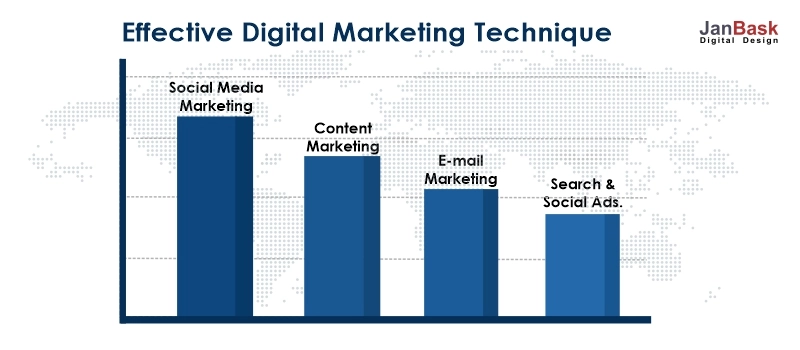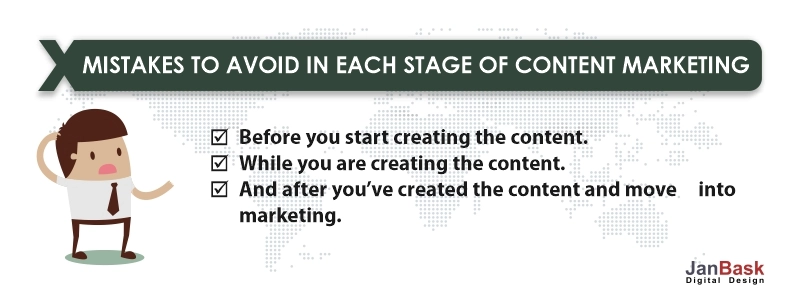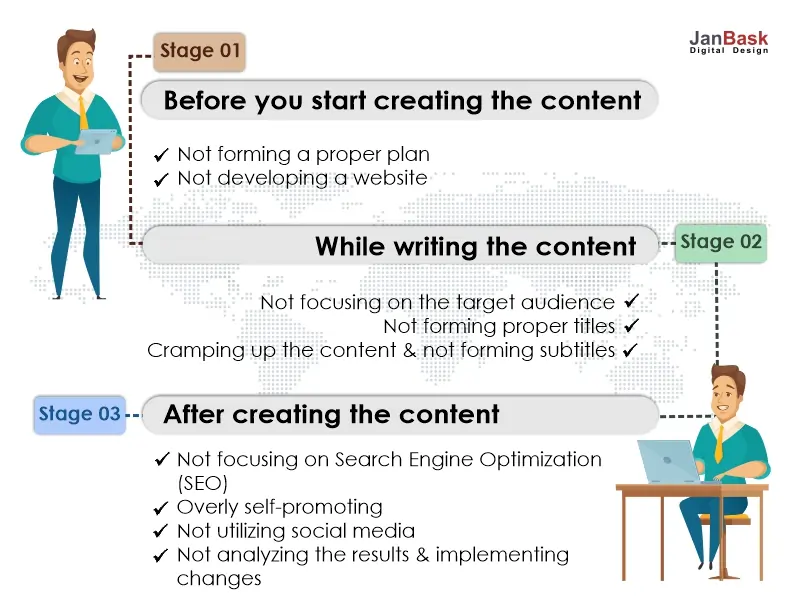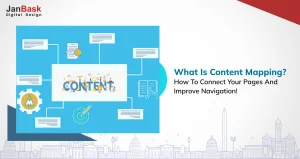
In the age of information with the internet pulling us deep into its clutches with every progressing day, it’s become easier than ever to grasp an audience and scream out your thoughts. With a few clicks, you can find hundreds of writers, thousands of blogs and lakhs of articles. Because of such fierce competition and such a wide reach, it’s also given way to a whole new field of – “content marketing”. Look at the effect it has:
Ideas are flooding through all our minds. And it’s ‘how’ you arrange those ideas, which will make or break your way to success and also make readers click on the back button within 1/100000th the time it took you to put the content up or make them want to scroll till the end.
More than 36,000,000 pieces of content hit the internet each day. And most of them are created by B to B marketers. So, with such fierce competition, it’s really difficult to stand out and make your campaign a success. When it comes to content marketing, there are thousands of things that can go right and millions of things that can go wrong. So, stick with us to find out which mistakes to avoid when it comes to content marketing!
We will divide the process into three stages and list out the mistakes to avoid in each stage:
- Before you start creating the content.
- While you are creating the content.
- And after you’ve created the content and move into marketing.
Stage -1: Before you start creating the content
Not forming a proper plan: You could be harming your success ratio before you even begin. And that’s by not forming an elaborate and in-depth plan. It’s of utmost importance to plan out your actions and the expected output from a long term perspective.
Focus on developing a unique idea. This is the reason for the failure of a lot of content marketing campaigns – not having a unique idea. With so much content out there, no one wants to read the same thing over and over again. Thus, following the footsteps of your competitor will ruin your chances of success. Thus, first and foremost, focus all your energy on finding a unique and rare idea for your content marketing campaign.
The next step is to plan everything out. The impact of content on your marketing goals, the expected output and how you are going to measure the output and the frequency of uploading, everything needs to be planned and you need to have a set plan for the future before you begin. Uploading consistently and earning a dedicated audience is of pivotal importance. And the main factor is maintaining this frequency. Not posting regularly after some time will affect your success ratio a lot.
Not developing a website: Your product’s/service’s online identity is your website. All the necessary information must be available and easy to access. And this includes the content you will be creating. Proper organization of content is a must when it comes to content marketing. And to get a more organized approach and let your audience view your content properly, developing a website is a must. And using your content, you can also drive traffic to your website. And while forming your website, keep in mind the following points :
Don’t make them click for 2 hours to finally find the content they want. Navigation must be easy and no unnecessary things should be mentioned. All the content you created must be easily available and accessible. You need it to be as professional as possible. But that doesn’t mean it has to look dull. Include videos, pictures and any visual content you can. With just a first look, potential customers must be able to figure out your brand, your uniqueness and what you offer.
Stage 2: While writing the content
Not focusing on the target audience: Target audience is basically for whom you’re writing the content. Every article is not written for every person. Though you want the majority of them to go through it, it’s generally written for a specific type of people. And this varies from article to article.
Now, I’ll dive into its importance. If you’re trying to sell something, your approach when you’re targeting a businessman is different from the approach you’ll use for a creative person. Similarly, the way you explain something to your grandma and your niece is different. Now use the same logic for your content. It’s important to look at your content from the reader’s perspective and accordingly mold it. Also, putting the interests and wants of your audience is more important than your interests. Rather than focusing on what you enjoy writing about, keep the interests of your audience at heart and create the content accordingly.
Not forming proper titles: The heading is the most important part of your content, sort of like the Holy Grail of your content. To market it properly, your audience should first want to read the content. And the title will determine whether your target audience will read your content or not. The heading/title of your content should follow these points:-
Properly convey your motive: The title should summarize your content into a word or a few words which are enough to catch the attention of the said audience, and make them want to read the content. It should be to the point. The audience must be able to understand what the article is exactly about by just a look. It should also be relevant, and not a clickbait, as clickbaits follow bad reviews and a bleak future.
It should be simple, short and precise: You do not want the title to be ‘embellishing your delicacy with dry extracts of crocus sativus’. Use quality words that are simple yet polished, keeping the title short and precise. Go with ‘Garnishing your meals with saffron’, and it will pull a bigger audience.
It should be powerful: The title is the flagship of a fleet of ships that is your content, so the title should be powerful enough to hold the content on its own.
Cramping up the content and not forming subtitles: Once you’ve managed to grasp their attention, you have to make them stay. Well, that’s the difficult part, isn’t it? Swamping your readers with pages and pages of paragraphs with tons of information right in their faces is what will make them lose interest. To make them get through the whole thing and scroll till the end, make your paragraphs short and sweet. This, in no way, means to reduce the words or minimize the content. Just space them out and form short paragraphs and give the readers space to think before moving to the next point.
Take a point and mold into a short sentence. Sentences which are too long will create unnecessary confusion. But short doesn’t mean bland. It means precise. So instead of beating around the bush, get straight to the point. Search for keywords and use SEO strategies to find the type of content you need to include. Properly framed, keyword rich content will drive in more traffic. Try not to drift too far away from the topic. Try to include visuals. Be it pictures, videos or anything you can imagine. Adding visuals can hold a reader’s attention and keep them interested and sometimes, helps them to understand the point in a better way.
Stage 3 : After creating the content
Once you’ve created the content and published it, you can’t expect it to do wonders and shoot up your success rate. The content needs to be properly marketed. Only by thorough marketing will it even reach the audience. To widen your reach and get maximum exposure, there are a lot of techniques. And here are the common mistakes you need to rule out:
Not focusing on Search Engine Optimization (SEO): When you search for something on any search engine, you see a number of sites in an order. Have you ever wondered why that order? And how some of these sites are at number 1 while some are on the 35th page? The answer is ‘Search Engine Optimization’.
SEO is an integral component of content marketing. It’s the art of making search engines believe that you are most fit for that first position in the results for certain keywords. So, spend a lot of time and resources to optimize your content. Focused on increasing the visibility of your content on the internet, investing your time and resources in SEO can be a vital move. It brings in traffic.
But with the constant algorithm updates, it’s getting harder to keep up. So, spend a lot of time and resources to optimize your site. Go through ‘Google’s Search Quality Guidelines’ to get a better idea. Keyword research and analysis could also get you a good spot on the rankings. Tools like Google Adwords Keyword Planner or Ubersugest are excellent to start with.
Overly self-promoting: It’s one of the most important points to remember – “Don’t indulge in self promotion a lot!”. Promoting your product/company/service in every content will have a negative impact on the success rate. Self promotion is more times than not, annoying for the readers and very close to advertising. Content marketing and advertising are two different things and differ a lot from one another. Through your content, provide the customers what they want and they will surely end up on your product/company/service website. Don’t self promote in every article. That takes away the essence of content marketing.
Not utilizing social media: Social media is ruling over the internet. Yes, it’s a great medium to socialize and share fun stuff. But in the last few years, it’s grown to be so much more than just that. And it’s found its root expanding and conquering different fields, including content marketing. Many a times, marketers just post the content on various platforms and be done with it. But that’s a waste of such a potential Social Media platform. There are no extents to which you can properly use social media to drive your content marketing.
Properly configuring a whole social media marketing strategy will aide your content marketing. Making use of tools and finding out the target audience’s preferred platforms, active hours, etc, will benefit you. Depending on your target audience, choose the platform on which you want to post the content. Thus, properly make use of different social media platforms and tools to drive your content marketing strategy.
Not analyzing the results and implementing changes: This is by far the most neglected and the most important step. Strategizing one plan and sticking to it, without analyzing the impact and making necessary changes will deprive you of a lot of profit. From time to time, you need to review the strategy and make the necessary changes.
This can be done by using various tools to analyze the results and outcome of your strategy and by reviews from the audience. You can again use social media to collect reviews from the audience and maintain a proper relationship. Based on the impact and result, you can formulate new strategies or make small adjustments in the current one to improve the results.
There you go! All the don’ts when it comes to content marketing. Content marketing is one of the simple yet effective ways to market your product/service. You just need to do a few basic things right. With a unique idea and proper strategy, you are on the right track. By creating proper content and making use of SEO and optimizing your content, you can drive in more and more traffic. Remember to keep your content focused on the target audience and post content regularly to hold onto your target audience. Properly follow the above golden rules and you are good to go! Don’t forget to share your views and thoughts with us!







Leave a Reply